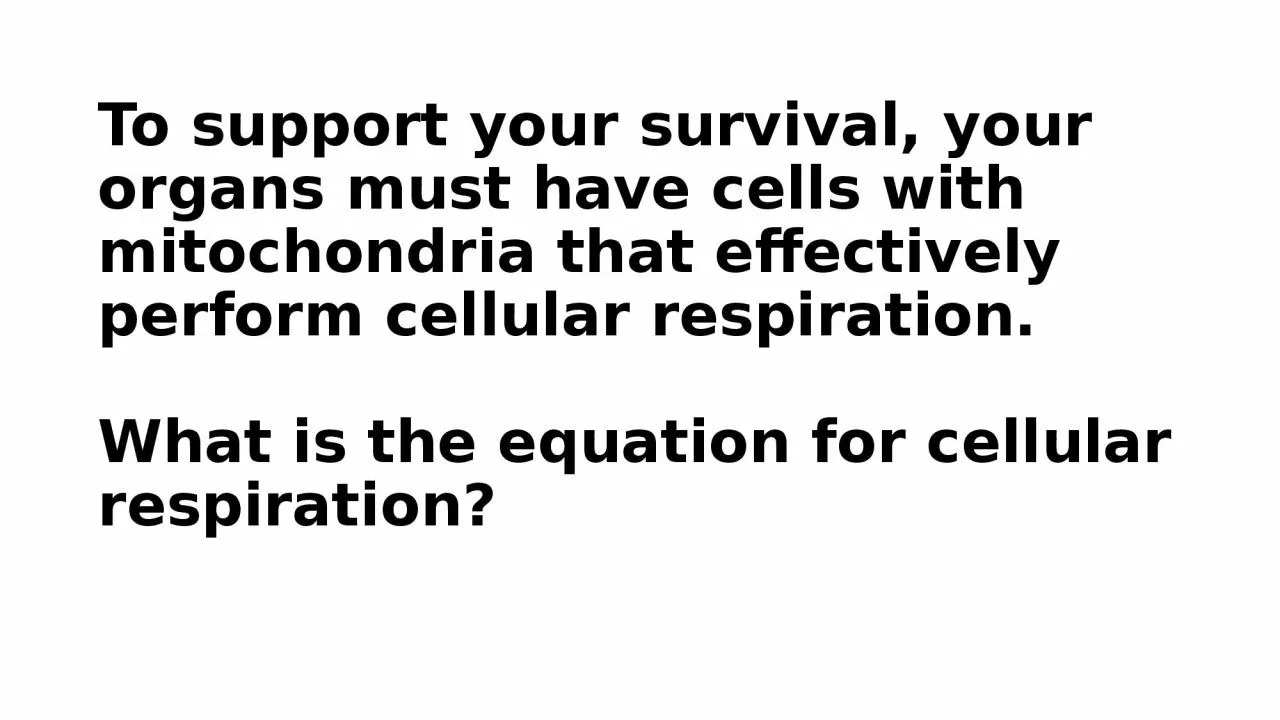

What is the equation for cellular respiration Equation is simple but the processes that support cellular respiration are complex Lets look at it in more detail Cellular respiration occurs in nearly all of the cells in the body with most of the key processes occurring in the mitochondria ID: 1034479
Download Presentation The PPT/PDF document "To support your survival, your organs mu..." is the property of its rightful owner. Permission is granted to download and print the materials on this web site for personal, non-commercial use only, and to display it on your personal computer provided you do not modify the materials and that you retain all copyright notices contained in the materials. By downloading content from our website, you accept the terms of this agreement.
1. To support your survival, your organs must have cells with mitochondria that effectively perform cellular respiration.What is the equation for cellular respiration?
2. Equation is simple but the processes that support cellular respiration are complex. Let’s look at it in more detail.Cellular respiration occurs in nearly all of the cells in the body, with most of the key processes occurring in the mitochondria.How does the glucose and oxygen get to the cells?glucoseC6H12O6carbon dioxideCO2waterH2OoxygenO2+++ATP
3. Source of cellular oxygen:The air has 21% oxygenOxygen enters the body through your mouth and nostrils when you breath in.Oxygen then travels down the trachea, then enters the lungs via the bronchi and bronchioles before entering the alveoliWithin the alveoli, oxygen crosses the thin membranes of the lung’s alveoli and the thin membranes of capillaries that surround the alveoli.
4. Once oxygen enters the capillaries, it will be picked up and carried in the red blood cells.The capillaries are associated with the circulatory system that carry blood and red blood cells past all cells in the body. When cells need oxygen, oxygen is downloaded from the red blood cells, in the blood, across the walls of the capillaries, and then across the walls of the cells where they are available to the mitochondria.Source of cellular oxygen:
5. Source of glucose:Glucose is a sugar. It can comes directly from the diet and the breakdown of other nutrients to glucose within, the body and particularly from the liver.Once you swallow your food, it passes from the mouth, to the esophagus, stomach, and intestine.In the intestine, broken down food molecules cross the thin cell walls of the intestine and cross the thin walls of capillaries and enter the circulation.
6. Source of glucose:The liver can make glucose from the breakdown of other macronutrients and transfer glucose into the circulation.Glucose is then delivered to the cells, where needed, much like oxygen is.
7. Cellular respiration:In the cell, glucose is broken down to acetyl-CoA by glycolysis.Acetyl-CoA is transferred into the mitochondrion.Acetyl-CoA enters the citric acid (TCA) cycle where CO2 is produced in the production of NADH and FADH2.NADH and FADH2 provide electrons to the electron transport chain.The electron transport chain uses the electrons to power the conversion of oxygen into water and to power the production of ATP.
8. Removing waste:The water that is produced by the electron transport chain can be used by the cells as needed or excreted by the body, after it re-enters the circulation and is delivered to the kidneys for release by urination.Carbon dioxide enter the circulation and it is release from capillaries at the lungs to the lungs alveoli. Carbon dioxide is released from the lungs when you exhale.